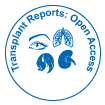Notre groupe organise plus de 3 000 séries de conférences Événements chaque année aux États-Unis, en Europe et en Europe. Asie avec le soutien de 1 000 autres Sociétés scientifiques et publie plus de 700 Open Access Revues qui contiennent plus de 50 000 personnalités éminentes, des scientifiques réputés en tant que membres du comité de rédaction.
Les revues en libre accès gagnent plus de lecteurs et de citations
700 revues et 15 000 000 de lecteurs Chaque revue attire plus de 25 000 lecteurs
Indexé dans
- Recherche de référence
- Université Hamdard
- EBSCO AZ
Liens utiles
Revues en libre accès
Partager cette page
Abstrait
Advancements in Lung Transplantation: A Comprehensive Review
Kaito A
Lung transplantation has emerged as a life-saving intervention for individuals with end-stage lung diseases. This report provides a thorough examination of recent advancements in the field of lung transplantation, encompassing key aspects such as surgical techniques, donor selection, immunosuppressive strategies, and post-transplant care. The document begins by outlining the evolution of lung transplantation, highlighting milestones and breakthroughs that have significantly improved patient outcomes. A detailed analysis of current surgical approaches, including double lung transplants and advancements in minimally invasive procedures, is presented. The critical role of donor selection criteria and emerging technologies for organ preservation are explored, emphasizing the ongoing efforts to expand the donor pool and enhance organ viability. Immunosuppression remains a cornerstone in preventing graft rejection, and this report delves into the latest developments in immunosuppressive therapies. From personalized medicine approaches to novel drug formulations, the aim is to strike a balance between preventing rejection and minimizing adverse effects. Additionally, the report discusses the growing importance of precision medicine in tailoring treatment regimens to individual patient profiles. Post-transplant care and complications are addressed, with a focus on strategies to mitigate common challenges such as infections, graft dysfunction, and long-term complications. The integration of telemedicine and remote monitoring in post-transplant follow-up is also explored, showcasing the potential for improved patient outcomes and healthcare efficiency. In conclusion, this report provides a comprehensive overview of the recent advancements in lung transplantation, shedding light on the multidimensional progress in surgical techniques, donor considerations, immunosuppressive strategies, and post-transplant care. The insights presented aim to contribute to the ongoing discourse in the field and inspire further innovations to enhance the success and accessibility of lung transplantation worldwide.
Revues par sujet
- Agriculture et Aquaculture
- Biochimie
- Chimie
- Food & Nutrition
- Génétique et biologie moléculaire
- Géologie et sciences de la Terre
- Immunologie et microbiologie
- Ingénierie
- La science des matériaux
- Le physique
- Science générale
- Sciences cliniques
- Sciences environnementales
- Sciences médicales
- Sciences pharmaceutiques
- Sciences sociales et politiques
- Sciences vétérinaires
- Soins infirmiers et soins de santé
Revues cliniques et médicales
- Allaitement
- Anesthésiologie
- Biologie moléculaire
- Cardiologie
- Chirurgie
- Dentisterie
- Dermatologie
- Diabète et endocrinologie
- Gastro-entérologie
- Immunologie
- La génétique
- Maladies infectieuses
- Médecine
- Microbiologie
- Neurologie
- Oncologie
- Ophtalmologie
- Pédiatrie
- Recherche clinique
- Soins de santé
- Toxicologie

 English
English  Spanish
Spanish  Chinese
Chinese  Russian
Russian  German
German  Japanese
Japanese  Portuguese
Portuguese  Hindi
Hindi